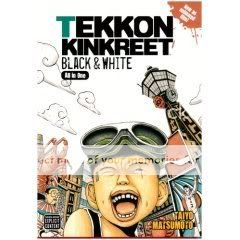Tekkon Kinkreet: Black and White
Taiyo Matsumoto, writer/artist
Lillian Olsen, translator
Viz, September 2007
624 pages
$29.95
Perhaps the most fascinating thing about Taiyo Matsumoto’s Tekkon Kinkreet is how its art constantly draws attention to its nature as art yet never compromises the totality of the story’s vision. Like a Gahan Wilson cartoon or Klaus Voorman’s cover for the Beatles’ Revolver, Matsumoto’s shaky—I almost wanna say gawky—line reveals itself as the product of a hand committing ink to paper on every page. Its largely uniform weight draws the eye to every detail at once, momentarily disabling the part of our brain that tricks us into seeing comics pages as three-dimensional environments rather than an assemblage of flat shapes, at least until Matusmoto’s skillful spotting of blacks (holy moses, check out page 538!) once again guides us back into the illusion.
Step back for a wider view and the gangly linework fits neatly with the spindly, frequently scarred characters, and the messy city they inhabit, most often viewed from the ground up like a lost child would see it. There’s a weakness to the art that is again reinforced by the story: On a certain level it’s a futuristic, dystopian crime-action thriller about rival factions (cops, street gangs, yakuza, a sinister religious/entertainment corporation, and two feral kids named Black and White) battling for control of a sprawling city called Treasure Town. But while the action is thrilling–and, refreshingly enough for a translated manga with a potentially byzantine plot, easy to follow–where the book really hits home is on an emotional level. Its elegiac feel is perhaps meant to recall real-world analogues like the Disneyfication of New York City, but for me it functions as a message about caring for people and things who are past caring for themselves. It’s defined by relationships between people who end up making themselves emotionally vulnerable and yoked to a belief in something better at great risk to themselves–streetwise Black’s love for his idiot-savant brother White, White’s love for his increasingly brutal brother Black, crimelord the Rat’s desire to preserve the city he’s mostly just stolen from, the cops’ desire to preserve even the criminal underclass against an encroaching and even more vicious modernity. Now, as someone who’s gotten a lot more enjoyment out of Disneyfied Times Square than Taxi Driver Times Square, many of the book’s more didactic moments and gangster poses fall flat with me. But there’s a part of everyone that still pines for wild youth, warts and all.
In the end almost all the characters are forced to choose the things that are most important to them and move on, leaving the rest behind, which is essentially how the process of growing up works. It’s a coming of age tale that actually feels like coming of age does. I’m really impressed by how slowly and naturally these themes unfold, too–Matsumoto has a grasp on pacing that makes this serialized work read just great in a collected edition. It’s all packed into a well-designed, hefty softcover, the kind of book that begs to be given as a gift or passed from reader to reader. Recommended.
Tags: comics, comics reviews, Comics Time, reviews

